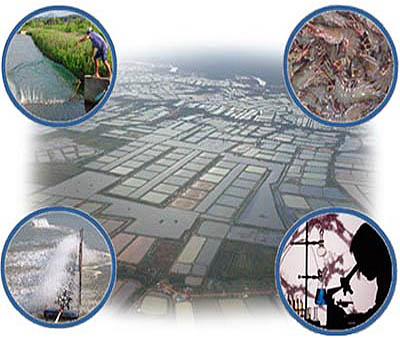SOURCE: GORDEN LABEDZ glabedzmd@aol.com
POSTED: 21 AUGUST 2006 - 8:30am HST
Kauai Shrimp Farm to dump in surfzone

aerial view: Kekaha shrimp farm along Kaumalii Highway. PMRF entrance at left edge of image.
| WHO:
Sunrise Capital Incorporated, 745 Fort Street, Honolulu, HI 96813 WHAT: The Dept. of Health approved dumping up to thirty million gallons of shrimp wastewater every day, directly over the beach into the surf. They OK’ed twenty thousand pounds of shrimp feces to be dumped in the surfzone daily. This waste will pass over the beach and go right into the nearshore water. All of this begins to happen on August 18, 2006 when the NPDES permit goes into affect. WHERE: Dumping in Kaiwaiele Stream will affect West Kaua’i Kini Kini, Majors Bay and Family Housing beach areas. These are all very popular surfing and recreation areas. GOOD NEWS: The shrimp farm was prohibited from dumping any chemicals into the ocean. No pesticides, growth hormones, antibiotics or chemical cleaners. MORE GOOD NEWS: They are prohibited from having visible foam or floating solids. This is a great improvement from the previous operation. STILL MORE SEMI GOOD NEWS: Since their waste discharge attracts both Galapagos and Tiger sharks into the surfzone, they must clean-up fish kills and warn surfers of the potential of shark attacks. BAD NEWS: Why do we have to wait for the waste discharge with fish kills to reach the ocean? These should be constantly monitored and prevented from reaching the ocean, but that is not required. All that is required is that they report the fish kill, clean up after the fact and keep possibly us out of the ocean (Navy regulations close any beach that a shark has been reportedly sighted at for 24 hours after the reported shark sighting). MORE BAD NEWS: Aside from the tens of thousands of pounds of gunk daily they will be permitted to discharge, they are also permitted to discharge the equivalent of around 200 bags of fertilizer daily into the surf. STILL MORE BAD NEWS: It is a “correct-your-own-homework” type of monitoring, they only have to check the water monthly and quarterly and they can do it any time they want instead of during an obvious pollution or fish kill episode. THE FUTURE: There is no reason why a shrimp farm should discharge its waste directly into the ocean. A shrimp farm can construct wetlands that can clean and treat the wastewater so it can flow to the beach with out harmful pollutants. Adjacent wetlands that the shrimp waste water could be sent to can serve as wild life habitat for Hawai’i’s endangered species. These same wetlands can grow other fish (Tilapia) that clean the water can serve as human food and provide more employment opportunities for local residents. The wetland plants can be composted and used as fertilizer for agriculture operations. The fact that the Department of Health allowed them to do the dumping “quick-and-dirty” and that the Department of Agriculture/Aquaculture promotes cheap coastal dumping of wastewater at the expense of our beaches and ocean, Hawai’i’s greatest resource, is truly a tragedy. Bruce Pleas hisurf3@hawaii.rr.com Phone (808) 337 9509, (808) 639 2850 Surfrider Foundation/Gordon LaBedz, MD GLaBedzMD@aol.com, (808) 337 9977 |
SOURCE: BRUCE PLEAS hisurf3@hawaii.rr.com
Expanding
West Kauai Shrimp Farm
20 May 2006 - 10:00pm HST

Shrimp farming enironmental problems as highlighted
by MicrOtac.com
Application
made for an NPDES Permit Bruce
Pleas Shrimp
farming enironmental problems 2) Availability
of leftover feed and phytoplankton dead cells created the accumulation
of undesirable organic wastes and toxic gases dissolved in shrimp
pond bottom soils and in most cases, mortality occurs when the
shrimp ponds bottom is polluted and deteriorated. When this occurs,
shrimp ponds soil become acidic, damages gills (black or brown
gills), burned and broken tails, zoothamnium, affected metabolism,
incidence of blue shrimp syndrome (due to nutritional deficiency),
molting process is disrupted (soft shell), and the onset of fouling,
vibiosis and other virus diseases occurs, thereby causing mortality. 3)The congested
number of shrimp ponds located in the same area of non-irrigation
causes the easily eradicated disease problems, and became uncontrollable
factors. The idea of culturing in a restricted environment and
hoping for a good harvest has been one of man's endeavor since
early days. However, the ecosystem existent in shrimp farming
all over the world experiences the most recurrent problem…is
how to get rid of the organic matters and organic wastes that
has accumulated during the culture cycle and how to imporve the
natural water resources before starting the new cycle. This problem
have been approached by designing different types of ponds waste
drains within the ponds system itself, filtration, aerators, air
supplies, oxidation ponds or recirlulating ponds systems, yet
no solution has yet been satisfactory today to correct the shrimp
farming problem. |